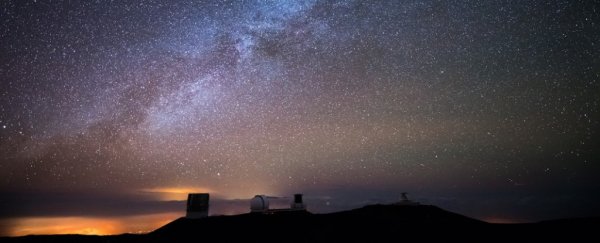Hundreds of protesters gathered at the base of a mountain in Hawaii on Monday to block the construction of a billion-dollar telescope on its peak. To Native Hawaiians, Mauna Kea is a sacred place. To astronomers, it is one of the best places on earth to observe space.
Hawaiian elders, known as kupuna, sat in the road in chairs while eight others shackled themselves to a metal grate in the road, according to the AP. Between 300 and 500 protesters stood where the Mauna Kea Access Road begins.
"We do not want this [telescope] on this mountain," Walter Ritte, one of the activists who had chained himself to the grate, told Hawaii News Now.
"This mountain represents more than just their building they want to build. This mountain represents the last thing they want to take that we will not give them."
Construction on the US$1.4-billion Thirty Meter Telescope, which the AP reports is expected to rise 18 stories tall, was set to begin Monday according to Hawaii's governor, David Ige. The announcement came after years of deliberation and protest.
In 2009, Mauna Kea was chosen as the place for the TMT, named for the diameter of its mirror, because of its elevation and clear skies. The telescope will be 18 stories tall and will provide astronomers an opportunity to better observe planets and stars forming, galaxies and black holes.
Peaceful protests began during a groundbreaking ceremony in 2014. In 2015, they prevented construction from beginning.
The Hawaii Supreme Court later affirmed a decision by the State Board of Land and Natural Resources to grant a building permit. And then in June 2019, the agency allowed the TMT to move further into construction, according to the TMT International Observatory.
Almost immediately after Hawaii became the 50th state in 1959, American scientists decided the summit of Mauna Kea was one of the best places on Earth to observe space.
The mountain "is a deeply sacred place that is revered in Hawaiian traditions," according to the Office of Hawaiian Affairs. "It's regarded as a shrine for worship, as a home to the gods."
Newly owned by the state's Department of Land and Natural Resources, Mauna Kea was leased to the University of Hawaii and other groups for the construction of observatories. Before the TMT, the mountain peak was already home to 13 other telescopes.
"We're losing all of the things that we're responsible for as Hawaiians," Ritte told Hawaii News Now.
"We're responsible for our oceans, we're responsible for our land, we're responsible for our future generations."
The University of Hawaii, which holds a lease for the land the telescopes are built on, said they want to engage a multitude of perspectives in the stewardship of the mountain going forward.
"We're trying to have as many conversations as possible with as many different stakeholders as possible," UH spokesperson Daniel Meisenzahl said.
Mailani Neal, a PhD student at New Mexico Institute of Mining and Technology, became interested in astronomy while she was learning about Hawaiian oceanic navigation and the traditional use of the stars as a child.
She has supported the construction of the TMT since she was in high school.
"I'm very proud to identify myself as a Native Hawaiian," Neal said. "At the same time, I'm also a scientist, I'm an astronomer and I believe that these two aspects of me can coexist. And I believe that astronomy and the culture can coexist on Mauna Kea."
No arrests were made on Monday, and those who had chained themselves to the grate were allowed to leave voluntarily, according to Hawaiian authorities. (Since then, some arrests have taken place, which you can read about here.)
After Monday's protests, Ige wrote on Facebook that the day had ended peacefully and he was committed to keeping everyone safe.
"To that end, a strong line of communication and respect between law enforcement and the protest leaders has been established," the statement said.
TMT spokesperson Scott Ishikawa said he could not comment about starting construction because of safety and security reasons. "We hope the protests remain peaceful and lawful as work begins," Ishikawa said.
On conference call, Jason Redulla, Chief, Division of Conservation and Resources Enforcement Unit at the Department of Land and Natural Resources, said on Tuesday there appeared to be fewer protesters but still "several hundred".
In case the site does not in fact work out, TMT has a backup plan to build the telescope in La Palma, Canary Islands, Spain.
2019 © The Washington Post
This article was originally published by The Washington Post.
